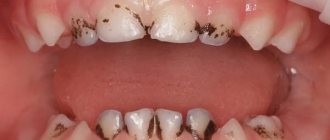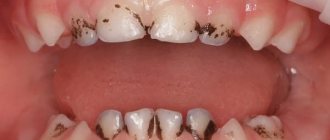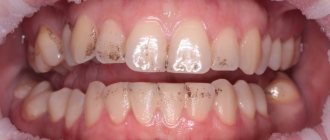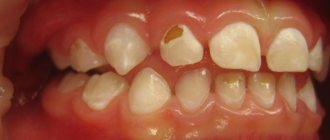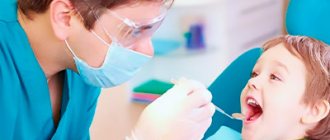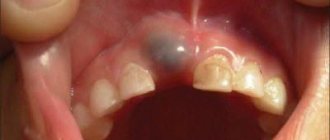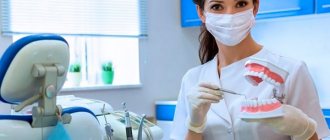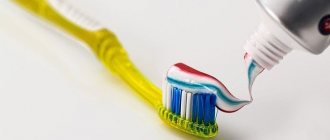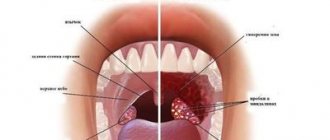In most cases, dental plaque is the cause of insufficient oral hygiene. But it also happens that people who are very sensitive to hygiene issues develop black plaque on their teeth.
The reasons for its appearance in adults and children differ : if in the former it is a consequence of drinking large amounts of tea and coffee, as well as smoking, then in the latter it may be associated with the activity of certain bacteria, the use of mouthwashes and the use of chewable vitamins.
Types of plaque
Plaque on teeth is divided into two large groups:
- the occurrence of which is associated with external contamination of the tooth;
- appearing due to the deposition of pigments.
If oral hygiene is not maintained, plaque may appear on the teeth:
- soft microbial;
- mineralized;
- hard, often called tartar.
If everything is in order with hygiene, then black plaque is a consequence of:
- regular consumption of tea, coffee and nicotine;
- use of medications with high iron content;
- vital activity of chromogenic bacteria;
- use of certain types of rinses and antiseptics.
Chlorhexidine: application in dentistry and ENT
Chlorhexidine solution has one unique property, which makes it the most effective antiseptic for the oral cavity.
When rinsing, a thin film of chlorhexidine bigluconate is formed on the surface of the oral mucosa, which continues to act after rinsing for several more hours (on average about 5-7 hours). Thus, the wide spectrum of action on most pathogenic bacteria and the high residual concentration of this antiseptic make it possible to effectively use it for the following dental and ENT diseases -
Important: at the end of the article you will find information on the specifics of using Chlorhexidine in each of the listed cases separately. This is important because In different situations there are certain subtleties of application.
Bacterial plaque on teeth: causes
Soft or, as it is also called, bacterial plaque has a soft consistency, so it is easy to get rid of it with the help of an ordinary toothbrush. The main place of its accumulation is the neck of the teeth.
Harder plaque that cannot be removed with a brush is called tartar. It occurs during the mineralization of soft plaque with phosphorus and calcium salts present in saliva.
Why does plaque form?
There are constantly a huge number of bacteria in the mouth, which, firstly , multiply, and secondly , leave behind waste products. Even if you brush your teeth regularly, plaque cannot be avoided: within 6 hours after thorough brushing, you can easily notice, without resorting to the use of specialized equipment, a bacterial mass on the surface of the tooth enamel. A surge in microbial activity is observed immediately after eating: leftover food in the mouth forces bacteria to begin intensive processing.
At the same time, even small pieces of food that are invisible to the human eye are enough for microorganisms: they can feed on a film consisting of carbohydrates and proteins that invariably remains on the surface of the teeth after eating, and on food debris that gets into the spaces between the teeth. In this regard, it is imperative to brush your teeth for 15 minutes after each meal, since the mass of bacterial plaque can increase several times in volume in 1-2 hours. Plaque accumulates especially intensely on the necks of teeth in people who like to snack on a bun or something sweet between main meals.
Almost immediately after the soft plaque appears, the process of mineralization begins, as a result of which it gradually hardens. The period of primary mineralization (i.e., when the plaque, in simple terms, “sets” but still remains loose) is 10-15 hours. When the plaque finally hardens, its surface becomes ideal for the formation of deposits.
Chlorhexidine: analogues
The drug does not have any direct analogues. Another antiseptic, Miramistin, can be considered as an indirect analogue, which has a completely different composition, but at the same time has a similar antiseptic effect (comparison of these drugs) at a significantly higher price.
However, there is a group of combined preparations (rinses and gels for the oral mucosa) that contain chlorhexidine. And below, we will list for you the most interesting products containing chlorhexidine.
We invite you to read why gums recede and the necks of teeth become exposed, how to treat and strengthen them
Pigmented dark plaque on teeth
The main reason for the appearance of such plaque in adults is smoking, drinking coffee and tea. Maintaining hygiene guarantees the absence of bacterial plaque and tartar, but if you neglect it, black plaque will not take long to appear. Pigments adhere very well to enamel covered with bacterial plaque formed as a result of infrequent brushing of teeth.
Types of pigment plaque include:
- brown coating that occurs from regular consumption of tea and coffee in large quantities;
- accumulation of nicotine deposits;
- darkening of the enamel as a result of taking medications containing iron;
- proliferation of bacteria that form dyes (they are called chromogenic);
- change in enamel color after using antibiotics;
- blackening due to diseases of internal organs.
If plaque is caused by bacterial factors, then regular thorough brushing of teeth, the use of rinses and floss reduce the likelihood of its occurrence to a minimum. However, if the reason for the appearance of plaque lies in the influence of dyes, maintaining hygiene to prevent it will not help.
Black plaque on children's teeth , the causes of which are associated with the activity of chromogenic anaerobic bacteria, appears in the form of spots localized in the neck area. Actinomycete bacteria produce hydrogen sulfite, which reacts with iron (found in saliva and red blood cells). As a result, a form of black iron that cannot be cleaned off with a regular brush is deposited on the surface of the teeth. Chromogenic coloration can also be orange, green and brown.
Black plaque on a child’s teeth can also form for other reasons . It appears due to:
- the use of antiseptics that contain chlorhexidine, benzaclonium chloride, as well as essential oils (the latter are found in the popular Listerine product);
- consumption of foods rich in iron, as well as vitamins with a high content of iron.
How to remove plaque from teeth on your own
Many people do not like to visit the dentist again, especially when it comes to removing plaque, which does not cause much inconvenience. The reasons for this are clear: lack of free time and reluctance to pay for the procedure.
You can try to remove plaque from your teeth at home, but this will only work if there are no subgingival deposits and the plaque layer is thin.
The first method involves using a special toothpaste to remove plaque with abrasive substances. The label of such pastes must indicate the RDA indicator, indicating the degree of abrasiveness. In pastes that eliminate plaque, its value should exceed 100. But such pastes cannot be used on an ongoing basis. If the paste contains pyrophosphates, then it can help get rid of tartar, since they have the ability to dissolve its matrix.
The most effective of these pastes are:
- President White Plus. The abrasiveness index is 200 units; in addition, the composition contains silicon dioxide, which has abrasive and polishing properties. You should not use the paste more than once a week.
- Lacalut White. According to the abrasiveness index (RDA=120), it is more gentle than the previous sample. The composition contains pyrophosphates, which make the plaque loose.
The second method is to use a special toothbrush, which allows you to remove plaque yourself. Recommended use:
Well, it’s very important -
- The duration of the course of antiseptic rinses - a course of mouth rinses with 0.05% chlorhexidine should not exceed 10-12 days, otherwise you will be guaranteed oral dysbacteriosis.
The use of solutions of 0.1-0.2% concentration is no longer than 8-10 days. Long-term use can lead to suppression of even good microflora and, over time, lead to a decrease in the local immunity of the oral mucosa, which will make the mucosa less resistant to the development of stomatitis and fungal infections. If you would like to continue the course of antiseptic rinses, then after the end of the 10-day period of using Chlorhexidine, it is better to switch to mouth rinses containing fluorides and extracts of medicinal plants. Such rinses will not harm you even with prolonged use.
- Remember that for gum inflammation, Chlorhexidine is effective only as part of complex therapy, and only after removing dental plaque. Don’t make the mistakes of many thousands of people who suppress the symptoms of inflammation with antiseptics and antibiotics, while the inflammation progresses unnoticed. When such people already go to the dentist, there is nothing that can be done to help them except to refer them for removal of loose teeth.
- An additional anti-inflammatory effect can be provided by the use of special anti-inflammatory toothpastes, which help strengthen the gums. Read more about choosing such hygiene products in our article: → Rating of toothpastes for bleeding
Plaque on a child’s teeth: treatment
Removing bacterial and chromogenic plaque in a child will be no different from a similar procedure recommended for an adult: ultrasonic cleaning and AirFlow are used in the same way.
However, chromogenic staining of teeth may return over time. The only possible solution to the problem is regular professional cleaning by a dentist. To make visits to the dentist as rare as possible, your child should be taught to use an electric toothbrush, the pulsating circular movements of the head of which perfectly break up plaque.
Accelerated formation of deposits is promoted by blood in the oral cavity, so the child’s gingivitis must be treated. The use of chlorhexidine and antiseptics based on it should be abandoned.
Chlorhexidine during pregnancy, in children -
To ensure that the use of chlorhexidine during pregnancy and lactation is safe, you need to follow simple rules.
- You should not have any open wounds in your mouth.
- Before using the drug, be sure to consult your doctor.
We suggest you read What to do if a blood clot falls out after tooth extraction
Chlorhexidine can be used without restrictions during pregnancy and breastfeeding, but preferably in courses of no more than 10 days. The drug is not absorbed into the blood and has only surface activity. Studies have not revealed a negative effect of the drug in these groups of patients. Chlorhexidine in children can also be used in short courses of up to 10 days (there is no age limit).
Important: children under 3 years old do not know how to rinse their mouths and therefore may choke. Therefore, their oral cavity can be treated either with gauze swabs soaked in an antiseptic solution, or using Chlorhexidine spray. However, keep in mind that in children under 3 years of age, the spray can be used to irrigate the mucous membrane of the entire oral cavity, with one exception - you cannot spray the spray into the throat or tonsils. The latter can only be done in children after 3 years of age.
Storage conditions -
- store in a place protected from light at a temperature not exceeding 25°C.
- shelf life: 2 years,
- store in places inaccessible to children,
- do not use after expiration date. We hope that our article on the topic: Chlorhexidine bigluconate instructions for use was useful to you!
Sources:
1. Additional. the author's professional education in periodontology, 2. Personal experience as a dental surgeon, periodontist, 3. National Library of Medicine (USA), 4. American Academy of Periodontology (USA), 5. Compositions of products taken from the official websites of manufacturers.
